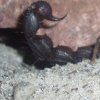- Joined
- Feb 12, 2003
- Messages
- 339
I recieved the breeding pair today, and have a few more questions. First, it appears that neither is an adult. The male is about 3.5 inches (could be an adult, I guess), and the female is 3 inches. Are they going to be any more likely to fight as sub-adults? Also, the male is missing part of his last leg, so he's slower than the female. As of now that's great, since the female is smaller. But when she gets big is that going to pose a problem?
Thanks for the input,
Chris
Thanks for the input,
Chris







